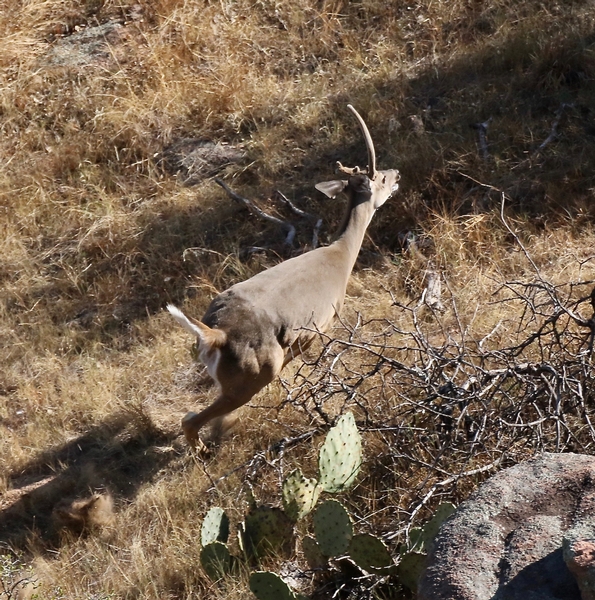
Velvet Antlered Bucks in the Fall

I receive dozens of calls each fall from concerned hunters from central Texas, more specifically Llano, Gillespie, San Saba, Burnet and Mason counties about seeing or harvesting late season velvet antlered bucks. The condition is called hypogonadism and it affects male deer primarily in the Central Basin, or Llano Uplift ecological area. These areas are rich in granite gravel soil types and this condition tends to show up in numbers in these general areas in drier years. I have seen it outside of this area, such as this mule deer buck I harvested last fall in Jeff Davis County near Fort Davis, but it is very prevalent in male whitetail deer in central Texas.
The condition is caused by a diminished function of the testicles and testosterone production affects all aspects of antler growth from production, growth itself and casting of the antlers so affected animals have unfinished, velvet covered antlers during the normal hunting season.
There have been only a handful of studies on hypogonadism and some date back to the late 1950’s but still very little is understood about the condition. Here are some things that we do know about it: We know that the velvet covered antlers, even in the late season, remains soft and pliable and not rigid like hard antlered bucks. The antlers are typically not shed and regrown but rather are maintained year around and often grow abnormally. The physical appearance of the affected bucks may look more feminine and they do not participate in rutting activity and are socially inferior, especially around other bucks. Testicles are either absent or are very small and the condition is irreversible. A buck may be affected at any time in his life with no predictability. I have seen bucks progress through the age classes as normal healthy deer and then one year the condition develops and that it is—they never “get over it” or recover and remain a stag for the remainder of his life.
Basically the condition is chemical castration from a biological sense. Antlers are produced and carried for breeding purposes and once the testicles are impacted, the antlers are impacted and the whole system falls apart so I recommend to all of my client to harvest each one they find. Removing the animal creates more space and more forage for the remaining healthy animals. The stag bucks are typically large bodied and in excellent physical condition, much like a steer is after castration. So from a wildlife production perspective, you don’t need a pasture full of stag bucks running around consuming resources and not adding to the genetic gains of the program.
Because the antlers are covered in velvet and are still soft, you need to protect them soon after harvest if you plan to preserve the rack. Placing the rack in a cooler or getting it to a taxidermist quickly is recommended if you want to preserve the velvet antlers. They are very easy to damage during transport so plan accordingly.
The meat from a buck with hypogonadism is perfectly fine to consume and may be better than the older rut and post-rut buck you might harvest later in the season so don’t be afraid to take these deer out of the herd and take them home to the family.
From a hunting license tagging perspective, these critters are still legally considered male animals so you must put a buck tag on it immediately after harvest.
Here are a few bucks I photographed this year with hypogonadism:


They certainly are unique and a great conversation piece! I enjoy seeing them and photographing them but I REALLY enjoy shooting them!
Posted in: Deer Management
